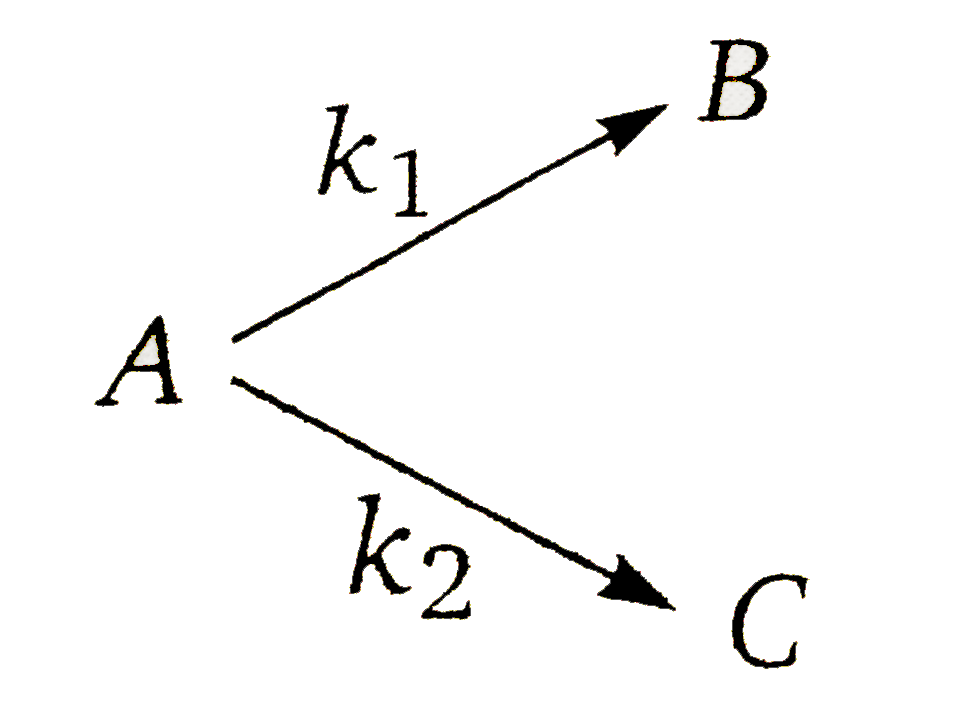The rate constant for two parallel reactions were found reactions were found to be 1.0×10–2 dm3 mol−1s–1and3.0×10–2 dm3 mol–1s–1. If the corresponding energies of activation of the parallel reactions are 60.0 kJ mol–1and70.0 kJ mol–1 respectively, what is the apparent overall energy of activation ?
130.0 kJ mol−1
67.5 kJ mol−1
100.0 kJ mol−1
65.0 kJ mol−1
The correct Answer is:B
To find the apparent overall energy of activation for the two parallel reactions, we can use the following formula:
EA,net=k1⋅E1+k2⋅E2k1+k2
Where:
- k1 and k2 are the rate constants for the two reactions.
- E1 and E2 are the activation energies for the two reactions.
Step 1: Identify the given values
- Rate constant for the first reaction, k1=1.0×10−2dm3mol−1s−1
- Rate constant for the second reaction, k2=3.0×10−2dm3mol−1s−1
- Activation energy for the first reaction, E1=60.0kJ/mol
- Activation energy for the second reaction, E2=70.0kJ/mol
Step 2: Convert activation energies to the same units
Since the activation energies are already in kJ/mol, we can proceed without conversion.
Step 3: Calculate the numerator
Calculate k1⋅E1+k2⋅E2:
k1⋅E1=(1.0×10−2)⋅(60.0×103)=6.0×102J/mol
k2⋅E2=(3.0×10−2)⋅(70.0×103)=21.0×102J/mol
Now, add these two results:
k1⋅E1+k2⋅E2=6.0×102+21.0×102=27.0×102J/mol
Step 4: Calculate the denominator
Calculate k1+k2:
k1+k2=(1.0×10−2)+(3.0×10−2)=4.0×10−2dm3mol−1s−1
Step 5: Substitute into the formula
Now substitute the values into the formula for EA,net:
EA,net=27.0×1024.0×10−2
Step 6: Calculate the overall activation energy
EA,net=27.0×1024.0×10−2=6750J/mol=67.5kJ/mol
Final Answer
The apparent overall energy of activation is 67.5kJ/mol.
---
- k1 and k2 are the rate constants for the two reactions.
- E1 and E2 are the activation energies for the two reactions.
- Rate constant for the first reaction, k1=1.0×10−2dm3mol−1s−1
- Rate constant for the second reaction, k2=3.0×10−2dm3mol−1s−1
- Activation energy for the first reaction, E1=60.0kJ/mol
- Activation energy for the second reaction, E2=70.0kJ/mol
Since the activation energies are already in kJ/mol, we can proceed without conversion.
Calculate k1⋅E1+k2⋅E2:
Calculate k1+k2:
Now substitute the values into the formula for EA,net:
EA,net=27.0×1024.0×10−2=6750J/mol=67.5kJ/mol
The apparent overall energy of activation is 67.5kJ/mol.
Topper's Solved these Questions
- BOOK - MOTIONCHAPTER - Chemical KineticsEXERCISE - Exercise - 2 (Level-I) (Introduction, Rate of reaction, Factor affecting rate of reaction, Effect of)14videos
Chemical Kinetics
- BOOK - MOTIONCHAPTER - Chemical KineticsEXERCISE - Exercise - 2 (Level-I) (Zero order reaction, 1st order reaction, 2nd order reaction & nth order reaction)12videos
Chemical Kinetics
- BOOK - MOTIONCHAPTER - Chemical KineticsEXERCISE - Exercise -1 (Mechanism of reaction and theories of reaction rate)6videos
Chemical Kinetics
- BOOK - MOTIONCHAPTER - CHEMICAL EQUILIBRIUMEXERCISE - Exercise - 420videos
CHEMICAL EQUILIBRIUM
- BOOK - MOTIONCHAPTER - CLASSROOM PROBLEMS EXERCISE - Electrochemistry22videos
CLASSROOM PROBLEMS
Similar Questions
Knowledge Check
- Question 1 - Select One
The rate constant for two parallel reactions were found to be 1.0×10−2dm3mol−1and3.0×10−2dm3mol−1s−1. If the corresponding energies of activation of the correspoing energies of activation of the parallel reaction are 60.0 Kj mol−1 and 70.0 KJ mol−1 respectively ,what is the apparent overall energy of activation ?
A130.0KJmol−1B67.5KJmol−1C100.0KJmol−1D65.0KJmol−1 - Question 2 - Select One
Consider the reaction.

The rate constant for two parallel reactions were found to be 10−2dm−2mol−1s−1 and 4×10−2dm−3mol−1s−1 . If the corresponding energies of activation of the parallel reaction are 100 and 120 kJ/mol respectively, what is the net energy of activation (Ea) of AA100 kJ/molB120 kJ/molC116 kJ/molD220 kJ/mol - Question 3 - Select One
Rate constant of two reactions are given below. Identifying their order of reaction
k=5.3×10−2Lmol−1s−1
k=3.8×10−4s−1A(i) second order, (ii) first orderB(i) first order, second orderC(i) zero order, (ii) first orderD(i) second order, (ii) zero order
The activation energies for forward and backward reactions in a chemical reaction are 30.5 and 45.4 kJ mol−1 respectively. The reaction is
View SolutionThe rate constant for the reaction in gaseous phase
O+O3→2O2 is 8.0×10−15 cm3 molecule−1s−1 at 298 K. Corresponding value in dm3 mol−1s−1 is :View SolutionThe activation energy for the forward reaction X→Y is 60kJmol−1 and ΔH is −20kJmol−1. The activation energy for the reverse reaction is
View SolutionThe rate constant of a reaction is found to be 3×10−3molL−1min−1. The order of the reaction is
View SolutionIf the activation enery for the forward reaction is 150kJ mol−1 and that of the reverse reaction is 260kJ mol−1. What is the ethalpy change for the reaction ?
View Solution

